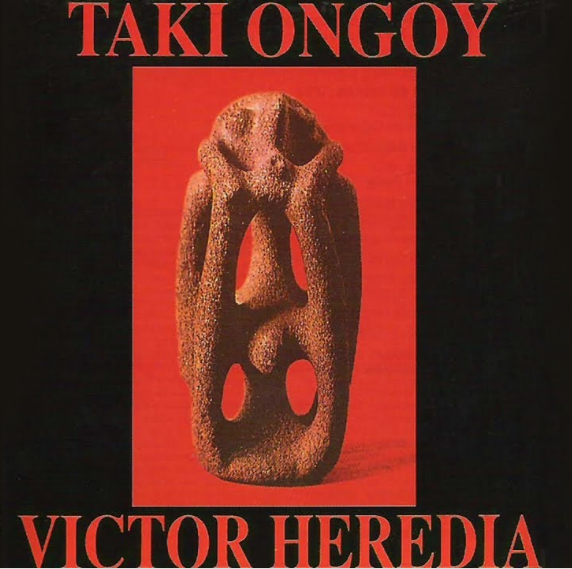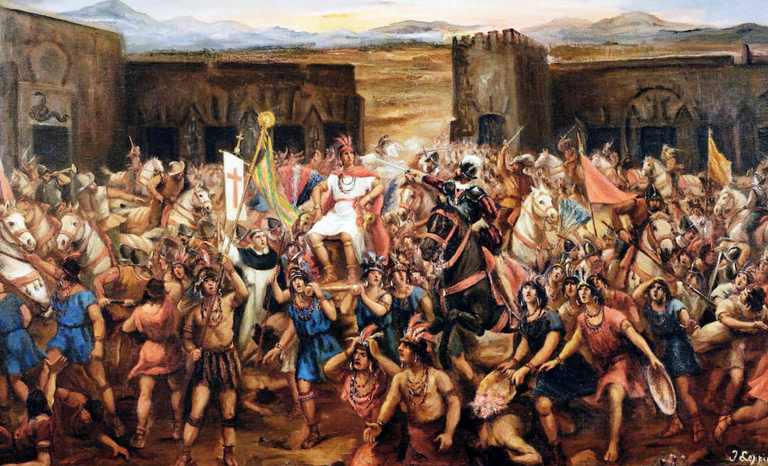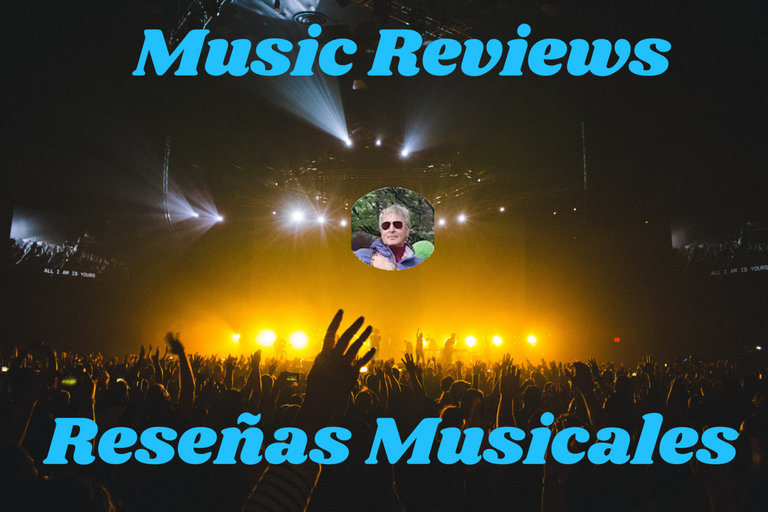
Taki Ongoy II (in Quechua: “La enfermedad del canto”) is an album released in 1986 by the Argentine singer-songwriter Víctor Heredia. It is a conceptual work reminiscent of the indigenous political and cultural movement of the same name (also written Taki Unquy), which arose in the Peruvian Andes during the 16th century against the recent Spanish invasion.
Victor Heredia is still making his “Taki Ongoy” 38 years later, that record that helped to awaken consciences and that became a symbol of Latin Americanism and one of the most important conceptual works of Argentine music.
This record (also live with the Orquesta Juvenil Sinfónica), was recreating a record through which thousands of people learned about “the history of the defeated” through this work.
Of the smallpox and the fevers brought by the Spaniards; of the 56 million massacred natives; of the bloodthirsty entrance of Pizarro to Cuzco in 1531 or of the betrayal of this one and the priest Valverde, that ended with the dismemberment of Atahualpa; of the rebellion of Tupac Amaru that ended with his head on the pike; of the Diaguita uprising of 1630 under the command of the brave Juan Chalimin to avenge and dignify his blood or of the eight million dead in the mines of Potosi, the uprising of the Calchaquies Valleys, a war that lasted 130 years; 13 years of terror and the rest of constant uprisings by people who tried to defend territories subjugated by another culture.
And, above all, that the homeland is 20 thousand years old. Undoubtedly, the work fulfilled its objective as a triggering work that awakens consciences.
The original work.

The artists Juan Carlos Baglietto, Jorge Fandermole and Mercedes Sosa participated in the original album.
The album was re-released in 2006, for its twentieth anniversary, the year in which Víctor Heredia offered a series of concerts at the Teatro Opera. That year the work was declared of Educational Interest by the National Ministry of Education.
In this new re-release, Babú Cerviño (piano and keyboards), Panchi Quesada (guitar), Ricky Zielinsky (bass), Gustavo López (drums), Víctor Carrión (aerophones) and Gabino Fernández (keyboards) were an ideal sound platform, very much at the height of the work. Each one with his score, following Heredia's epic, accurate and clear tone. And illuminating songs with melodically impeccable arrangements (“Ella está conmigo” and “Un pedazo de mi sangre” in particular) or adding funk touches to the already rhythmic version of “La puerta del Cosmos”.
Structure of the work
The following is a description of the songs that make up the album:
First part Second part Third part Fourth part Fifth part Sixth part Seventh part
Text nº 1
Talks of the sages and elders (Nahuaxl - Nuahatlacolli)
Twenty thousand years Patria
Taki Ongoy
The door to the cosmos
Text nº2
Meeting in Cajamarca
Death of Atahualpa
Text nº3
Year 1530 - Plague
Aya Marcay Quilla
Taki Ongoy n.º 2
Death of Tupac Amaru
Text nº4 (The great Diaguita uprising - 1630/1643)
Don Juan Chalimín
Mutilations
The head of Pedro Chumay
A piece of my blood
Text nº5
Song for the death of Juan Chalimín
Text nº6
Potosí
Text nº7
A sweet potter
She is with me
A land without memory
MY OPINION
The happy idea of summoning diverse cultural expressions of six native peoples palliated a part of that insistent, obsessive, almost impotent uneasiness that Taki Ongoy generated, generates and will generate for those to whom the history of the defeated becomes flesh.
It is too heartbreaking to listen again to “Qué abismo abrirá sus fauces / para tragargar mi dolor”, when the singer-songwriter refers to the death of Atahualpa. It overwhelms as much as it rebels to recall that they killed him because they gave him a book to listen to the word of the new god, and he threw it to the ground because that god “did not want to talk to him” (“Encuentro en Cajamarca”). It pierces the soul to review that the bones of eight million Indians rotted in the mines (“Potosí”) or that there were Diaguita women whose breasts were cut off (“Mutilaciones”).
Because Taki Ongoy is the crudest, most beautiful and pedagogical expression ever made to denounce one of the most silenced genocides in the universe and, as such, it generates anguish, introspection, mea culpa, catharsis, knowledge. Hence, the validity of noting the continuity of a culture. The survival of the reverse side of the coin of which Heredia speaks in the prologue. The culture that underlies “painful and melancholic” in an unconscious made of two muds.
Taki Ongoy II (en quechua: "La enfermedad del canto") es un álbum editado en 1986 por el cantautor argentino Víctor Heredia. Se trata de una obra conceptual que recuerda al movimiento indígena político y cultural del mismo nombre (también escrito Taki Unquy), surgido en los andes peruanos durante el siglo XVI contra la reciente invasión española.
Víctor Heredia sigue haciendo su "Taki Ongoy" 38 años después, ese disco que ayudó a despertar consciencias y que se transformó en todo un símbolo del latinoamericanismo y una de las obras conceptuales más importante de la música argentina.
Este registro (también en vivo es con la Orquesta Juvenil Sinfónica), fue recreando un disco por el cual miles de personas se enteraron de "la historia de los vencidos" a traves de esta obra.
De la viruela y las fiebres traídas por los espanoles; de los 56 millones de nativos masacrados; del ingreso sanguinario de Pizarro al Cuzco en 1531 o de la traición de este y el sacerdote Valverde, que terminó con el descuartizamiento de Atahualpa; de la rebelión de Tupac Amaru que acabó con su cabeza en la pica; del alzamiento diaguita de 1630 al comando del bravo Juan Chalimin para vengar y dignificar su sangre o de los ocho millones de muertos en la minas del Potosí, el levantamiento de los Valles Calchaquies, una guerra que duro 130 años; 13 de terror y el resto de levantamientos constantes por parte de gente que intentaba defender territorios avasallados por otra cultura.
Y, sobre todo, que la patria tiene 20 mil años. Sin dudas, el trabajo cumplió con su objetivo de obra disparadora, que despierta conciencias.
La obra original.

Del disco original participaron los artistas Juan Carlos Baglietto, Jorge Fandermole y Mercedes Sosa.
El álbum fue reeditado en 2006, para su vigésimo aniversario, año en que Víctor Heredia ofreció una serie de recitales en el Teatro Opera. Ese año la obra fue declarada de Interés Educativo por el Ministerio de Educación de la nación.
En esta nueva reedición estuvieron Babú Cerviño (piano y teclados), Panchi Quesada (guitarra), Ricky Zielinsky (bajo), Gustavo López (batería), Víctor Carrión (aerófonos) y Gabino Fernández (teclado) fueron un plafón sonoro ideal, muy a la altura de la obra. Cada uno con su partitura, siguiendo el tono épico, certero y claro de Heredia. E iluminado canciones con arreglos melódicamente impecables (“Ella está conmigo” y “Un pedazo de mi sangre” en especial) o agregando toques funk a la de por sí rítmica versión de “La puerta del Cosmos”.
Estructura de la obra
La siguiente es una descripción de las canciones que componen al álbum:
Texto nº 1
Pláticas de los sabios y ancianos (Nahuaxl - Nuahatlacolli)
Veinte mil años Patria
Taki Ongoy
La puerta del cosmos
Texto nº2
Encuentro en Cajamarca
Muerte de Atahualpa
Texto nº3
Año 1530 - Peste
Aya Marcay Quilla
Taki Ongoy n.º 2
Muerte de Túpac Amaru
Texto nº4 (El gran alzamiento diaguita - 1630/1643)
Don Juan Chalimín
Mutilaciones
La cabeza de Pedro Chumay
Un pedazo de mi sangre
Texto nº5
Canción por la muerte de Juan Chalimín
Texto nº6
Potosí
Texto nº7
Un dulce alfarero
Ella está conmigo
Una tierra sin memoria
MI OPINION
La feliz idea de convocar diversas expresiones culturales de seis pueblos originarios palió una parte de ese malestar insistente, obsesivo, casi impotente que generó, genera y generará Taki Ongoy a quienes la historia de los vencidos se les hace carne.
Demasiado desgarrador es escuchar otra vez “Qué abismo abrirá sus fauces / para tragar mi dolor”, cuando el cantautor refiere la muerte de Atahualpa. Abruma tanto como rebela rememorar que lo mataron porque le dieron un libro para escuchar la palabra del nuevo dios, y lo arrojó al suelo porque ese dios “no le quiso hablar” (“Encuentro en Cajamarca”). Perfora el alma revisar que huesos de ocho millones de indios se pudrieron en las minas (“Potosí”) o que hubo mujeres diaguitas a las que les cercenaron los pechos (“Mutilaciones”).
Porque Taki Ongoy es la expresión más cruda, bella y pedagógica que se haya hecho hasta hoy para denunciar uno de los genocidios más silenciados del universo y, como tal, genera angustia, introspección, mea culpa, catarsis, conocimiento. De ahí, la validez de constatar la continuidad de una cultura. La supervivencia del reverso de la moneda del que habla Heredia en el prólogo. La cultura que subyace “dolorida y melancólica” en un inconsciente hecho de dos barros.
Source images / Fuente imágenes: Victor Heredia.

Fuentes consultadas (de mi propiedad) para la elaboración del presente artículo. Algunos párrafos pueden estar reproducidos textualmente.
| Argentina Discovery. |  | |
|---|---|---|
| Galería Fotográfica de Argentina. |  | |
| Viaggio in Argentina. |  |
Upvoted. Thank You for sending some of your rewards to @null. Get more BLURT:
@ mariuszkarowski/how-to-get-automatic-upvote-from-my-accounts@ blurtbooster/blurt-booster-introduction-rules-and-guidelines-1699999662965@ nalexadre/blurt-nexus-creating-an-affiliate-account-1700008765859@ kryptodenno - win BLURT POWER delegationNote: This bot will not vote on AI-generated content
Thanks @ctime.